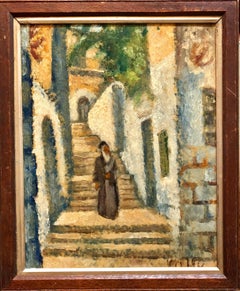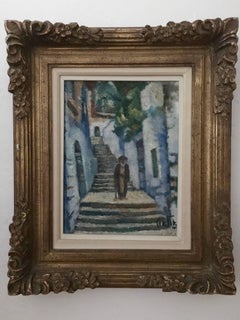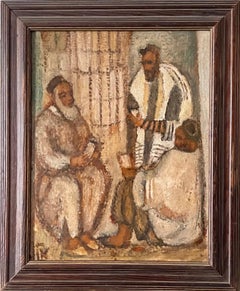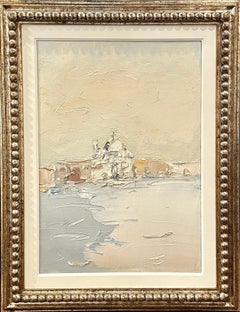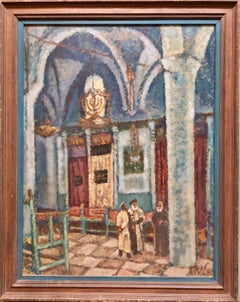Arieh Allweil Art
to
3
3
Rabbi in Jerusalem Modernist Israeli Judaica Oil Painting Arie Alweil Viennese
By Arieh Allweil
Located in Surfside, FL
ARIEH ALLWEIL [ARIE ALWEIL] 1901-1967
Galicia 1901-1967 Safed, Israel (Ukranian/Polish/Israeli)
Arieh Allweil, born 1901, Galicia. Immigrated to Palestine in1920. Studies: 1921-25 Art Academy, Vienna; Dresden Academy. ALlweil brought with him the high values of the Central European avant-garde, which he had absorbed during his years of study in Vienna. He joined the ‘Kunstschau’ group- of artists that had formed around Gustav Klimt and Egon Schiele. He exhibited with them in the 1920’s, and emigrated to Palestine in 1926. He was one of the founders of the Tel Aviv Art Museum and the Midrasha Art Teachers College in Israel. As opposed to other modern Israeli artists in his period, Allweil's woodcuts and illustrations pertained to contemporary events such as the Holocaust and the pioneering spirit before the establishment of the State of Israel. Most notable is this work as well as the first illustrated Passover Haggada for the IDF which he made in 1950 and which was printed for 3 years with his inspirational woodcut illustrations. He published a series of linoleum cuts of Israeli and Biblical subjects and created large scale murals of the Holocaust.
Teaching: In Israel, art. Prizes: Received Dizengoff Prize twice; 1955 Turov Prize for Bible Illustrations. Published series of linoleum cuts of Israeli and Biblical subjects, also illustrated a Passover Haggada and large scale murals of Holocaust. From 1952 until his death lived in Tel Aviv and in Safed in summer. Died 1967, Safed.
Education
1921-25 Art Academy, Vienna, Austria
1921-25 Dresden Academy, Germany
Teaching
Herzliyah Gymnasium High-School, Israel, art.
Tel Aviv High School
Awards And Prizes
1937 Dizengoff Prize for Painting and Sculpture,
Tel Aviv Museum of Art, Municipality of Tel Aviv-Jaffa
1946 Dizengoff Prize
1955 Turov Prize for Bible Illustrations
Select Solo Exhibition:
1933 Tel Aviv Museum, Solo Exhibition
1942 Katz Gallery, Tel Aviv
1950 Tel Aviv Museum, Tel Aviv
1956 The Blue Dome, Safed
1968 Memorial Exhibition of the artist Arieh Allweil Yad Labanim Museum, Petach-Tikva
1969 Solo Exhibition The Knesset, Jerusalem
1987 Arieh Allweil: 1901-1967 - ''Return to Betanya Ilit'' Beit Gabriel, Zemah
1994 Arieh Allweil: Prints and Caligraphy The Isaac Kaplan Old Yishuv Court Museum,Jerusalem
2011 Arieh Allweil, Letters, Figures, Landscapes
Mishkan Le'omanut, Museum of Art, Kibbutz Ein Harod
Select Group Exhibitions
1929 Eged - Palestine Painters Group Allenby Street, Tel Aviv
Artists: ChanaOrloff, Abraham Melnikoff, Reuven Rubin, Nachum Gutman, Sionah Tagger, Arieh Allweil, Haim Gliksberg, Yossef Zaritsky, Leon Arie Fein, Pinchas Litvinovsky, Elias Newman.
1932 The Bezalel National Museum, Jerusalem
Artists:
Litvinovsky, Pinchas Gutman, Nachum Allweil, Arieh
Exhibition of Artists: P. Litvinovsky, A. Allweil, N. Gutman
1936 First Exhibition of ''Hever Omanim'' Steimatzky Galleries, Jerusalem
Artists:
Gutman, Nahum Holzman, Shimshon Moshe Mokady, Miron Sima, Jakob Steinhardt, Zeev Ben Zvi, Moshe Ziffer, Allweil, Arieh.
1944 Collective Annual Exhibition by Palestinian Artists
Art Gallery of the ''Habima'' Building, Tel Aviv
Artists:
Hermann Struck, Hermann Moshe Sternschuss, Arie Reznik, Aaron Priver, Itzhak Danziger, Itzhak Zvi Aldouby, Menahem Shemi...
Category
20th Century Modern Arieh Allweil Art
Materials
Canvas, Oil
Rabbi in Jerusalem, Oil Painting Austrian Israeli Modernist Tel Aviv Museum
By Arieh Allweil
Located in Surfside, FL
ARIEH ALLWEIL [ARIE ALWEIL] 1901-1967
Galicia 1901-1967 Safed, Israel (Ukranian/Polish/Israeli)
Arieh Allweil, born 1901, Galicia. Immigrated to Palestine in1920. Studies: 1921-25 Art Academy, Vienna; Dresden Academy. ALlweil brought with him the high values of the Central European avant-garde, which he had absorbed during his years of study in Vienna. He joined the ‘Kunstschau’ group- of artists that had formed around Gustav Klimt and Egon Schiele. He exhibited with them in the 1920’s, and emigrated to Palestine in 1926. He was one of the founders of the Tel Aviv Art Museum and the Midrasha Art Teachers College in Israel. As opposed to other modern Israeli artists in his period, Allweil's woodcuts and illustrations pertained to contemporary events such as the Holocaust and the pioneering spirit before the establishment of the State of Israel. Most notable is this work as well as the first illustrated Passover Haggada for the IDF which he made in 1950 and which was printed for 3 years with his inspirational woodcut illustrations. He published a series of linoleum cuts of Israeli and Biblical subjects and created large scale murals of the Holocaust.
Teaching: In Israel, art. Prizes: Received Dizengoff Prize twice; 1955 Turov Prize for Bible Illustrations. Published series of linoleum cuts of Israeli and Biblical subjects, also illustrated a Passover Haggada and large scale murals of Holocaust. From 1952 until his death lived in Tel Aviv and in Safed in summer. Died 1967, Safed.
Education
1921-25 Art Academy, Vienna, Austria
1921-25 Dresden Academy, Germany
Teaching
Herzliyah Gymnasium High-School, Israel, art.
Tel Aviv High School
Awards And Prizes
1937 Dizengoff Prize for Painting and Sculpture,
Tel Aviv Museum...
Category
20th Century Modern Arieh Allweil Art
Materials
Canvas, Oil
Synagogue Interior Jerusalem Modernist Israeli Judaica Oil Painting Rabbi Prayer
By Arieh Allweil
Located in Surfside, FL
ARIEH ALLWEIL (ARIE ALWEIL) 1901-1967
Galicia 1901-1967 Safed, Israel (Ukrainian/Polish/Israeli)
Arieh Allweil, born 1901, Galicia. Immigrated to Palestine in 1920. Studies: 1921-25 Art Academy, Vienna; Dresden Academy. Alweil brought with him the high values of the Central European avant-garde, which he had absorbed during his years of study in Vienna. He joined the ‘Kunstschau’ group- of artists that had formed around Gustav Klimt and Egon Schiele. He exhibited with them in the 1920’s, and emigrated to Palestine in 1926. He was one of the founders of the Tel Aviv Art Museum and the Midrasha Art Teachers College in Israel. As opposed to other modern Israeli artists in his period, Allweil's woodcuts and illustrations pertained to contemporary events such as the Holocaust and the pioneering spirit before the establishment of the State of Israel. Most notable is this work as well as the first illustrated Passover Haggada for the IDF which he made in 1950 and which was printed for 3 years with his inspirational woodcut illustrations. He published a series of linoleum cuts of Israeli and Biblical subjects and created large scale murals of the Holocaust.
Teaching: In Israel, art. Prizes: Received Dizengoff Prize twice; 1955 Turov Prize for Bible Illustrations. Published series of linoleum cuts of Israeli and Biblical subjects, also illustrated a Passover Haggadah and large scale murals of Holocaust. From 1952 until his death lived in Tel Aviv and in Safed in summer. Died 1967, Safed.
Education
1921-25 Art Academy, Vienna, Austria
1921-25 Dresden Academy, Germany
Teaching
Herzliyah Gymnasium High-School, Israel, art.
Tel Aviv High School
Awards And Prizes
1937 Dizengoff Prize for Painting and Sculpture,
Tel Aviv Museum of Art, Municipality of Tel Aviv-Jaffa
1946 Dizengoff Prize
1955 Turov Prize for Bible Illustrations
Select Solo Exhibition:
1933 Tel Aviv Museum, Solo Exhibition
1942 Katz Gallery, Tel Aviv
1950 Tel Aviv Museum, Tel Aviv
1956 The Blue Dome, Safed
1968 Memorial Exhibition of the artist Arieh Allweil Yad Labanim Museum, Petach-Tikva
1969 Solo Exhibition The Knesset, Jerusalem
1987 Arieh Allweil: 1901-1967 - ''Return to Betanya Ilit'' Beit Gabriel, Zemah
1994 Arieh Allweil: Prints and Calligraphy The Isaac Kaplan Old Yishuv Court Museum,Jerusalem
2011 Arieh Allweil, Letters, Figures, Landscapes
Mishkan Le'omanut, Museum of Art, Kibbutz Ein Harod
Select Group Exhibitions
1929 Eged - Palestine Painters Group Allenby Street, Tel Aviv
Artists: ChanaOrloff, Abraham Melnikoff, Reuven Rubin, Nachum Gutman, Sionah Tagger, Arieh Allweil, Haim Gliksberg, Yossef Zaritsky, Leon Arie Fein, Pinchas Litvinovsky, Elias Newman.
1932 The Bezalel National Museum, Jerusalem
Artists: Pinchas Litvinovsky, Gutman Nachum Allweil, Arieh
1936 First Exhibition of ''Hever Omanim'' Steimatzky Galleries, Jerusalem
Artists: Gutman, Nahum Holzman, Shimshon Moshe Mokady, Miron Sima, Jakob Steinhardt, Zeev Ben Zvi, Moshe Ziffer...
Category
20th Century Modern Arieh Allweil Art
Materials
Canvas, Oil, Board
Related Items
Venezia
Located in Firenze, FI
Title: "Venezia"
Media: Oil on canvas
size: 50 x 70 cm
Sergio Scatizzi Lucca 1918 – Florence 2009
Art and nature are the themes of Scatizzi’s work of a journey through contemporan...
Category
1990s Modern Arieh Allweil Art
Materials
Oil, Canvas
Figurative landscape oil painting- The Spring
Located in Beijing, CN
Dai Xiangwen was born in Hunan in 1991 and graduated from the Academy of Fine Arts of Jianghan University,
He is a member of China Artists Association, China Designers Association, a painter of Li Keran...
Category
2010s Modern Arieh Allweil Art
Materials
Canvas, Oil
The Artist's Wife oil painting by Hans Burkhardt
By Hans Burkhardt
Located in Hudson, NY
Hans Burkhardt
The Artist's Wife (1930)
Oil on canvas, 20" x 16"
24" x 20 ½" x 1 ½" framed
Dated 1930 lower right recto. Annotated "To Elsa HB Louise Burkhardt 1930. HB" verso.
...
Category
1930s American Modern Arieh Allweil Art
Materials
Oil, Canvas
Mid Century Modern Portrait of Woman in Green Dress Original Oil Painting
By Genevieve Rogers
Located in Soquel, CA
Mid Century Modern Portrait of Woman in Green Dress Original Oil Painting
Evocative mid century modern portrait of woman in green dress by California artist Genevieve Rogers (America...
Category
1960s American Impressionist Arieh Allweil Art
Materials
Canvas, Oil, Illustration Board
H 21.5 in W 24.5 in D 1 in
Antique American School Harlem Renaissance Era Black Figure Dancing Painting
Located in Buffalo, NY
Antique American modernist interior scene oil painting. Oil on board. Framed. Image size, 20L x 16H.
Category
1940s Modern Arieh Allweil Art
Materials
Canvas, Oil
H 22 in W 26 in D 2 in
1940s New York Interior -- An Evening Scene of Artist and His Wife
Located in Soquel, CA
1940s New York Interior -- An Evening Scene of Artist and His Wife
Wonderful moody 1940s New York interior and figurative oil painting in Ashcan Schoo...
Category
1940s Ashcan School Arieh Allweil Art
Materials
Oil, Canvas, Cardboard
H 15.5 in W 19.5 in D 0.75 in
Red Couch, Black Cat - Contemporary Fauvist Interior Scene in Primary Colors
By Jonathan Taylor
Located in Soquel, CA
Fun and colorful contemporary Fauvist interior scene of a black cat lounging on a red couch in a brightly hued room in primary colors, by Jonathan Taylor (American, b.1966).
Signed...
Category
2010s Fauvist Arieh Allweil Art
Materials
Canvas, Oil, Cardboard
H 19.5 in W 23.5 in D 1.5 in
Woman from behind oil painting
By Rafael Duran Benet
Located in Barcelona, Barcelona
Rafael Duran Benet (1931-2015) - Woman from behind - Oil on canvas cardnoard
Oil measurements 55x46 cm.
Frameless.
Rafael Duran Benet (Terrassa, 1931 - Barcelona, 2015) is a Catalan...
Category
1990s Post-Impressionist Arieh Allweil Art
Materials
Canvas, Oil, Cardboard
"Tailor" WPA American Scene Social Realism Modernism Mid Century Modern Fashion
By Mervin Jules
Located in New York, NY
"Tailor" WPA American Scene Social Realism Modernism Mid Century Modern Fashion
The board measures 9 1/2 x 15 1/2.
Provenance: Mervin Jules Estate.
Bio
A painter, illustrator, pri...
Category
1930s American Modern Arieh Allweil Art
Materials
Oil, Board
The Demogogue
Located in Los Angeles, CA
The Demagogue or Tale in a Tub, 1952, oil on canvas, 20 x 24 inches, signed, titled, and dated verso
About the Painting
The Demagogue is an iconic Bendor Mark painting from the prime of his post-war period. Beginning early in his career, Mark was fascinated with depictions of the human figure and their capacity to tell stories of the world around him. Mark was a keen observer of his times and in The Demagogue we see Mark’s portrayal of a faithless politician holding up a “V” for victory sign as he appeals to the wanton desires and prejudices of the masses. Below the demagogue is a swirl of humanity representing the common man who is being pushed down by the powerful, while the robed figure of liberty with her scales of justice held high is brushed aside. Behind the demagogue, Mark places two other powerful supporting institutions which were often co-opted by the world’s dictators, the Church and the Military. Mark was an internationalist, so it is difficult to know exactly which demagogue inspired him to create this work, but in 1952 there were many to choose from. Whether depicting Argentina’s Peron (the demagogue and the women to the right resemble Juan and Eva Peron), Spain’s Franco or the United States’ homegrown fear mongers like Joseph McCarthy, Mark tells a universal story that unfolded in dramatic fashion during the post-war period as nations and their peoples grappled with authoritarianism and anti-democratic impulses. Stylistically, The Demagogue draws on the elements which make Mark’s work from this period immediately recognizable, a saturated palette, a closely packed and frenetic composition, exaggerated figuration and stylized facial features. But, above all, we see Mark’s ability to tell the stories of the rich and powerful and their ability to oppress. Like Mark’s work in the collection of the Whitney Museum of American Art (The Hourglass - 1950-51) and the Los Angeles County Museum of Art (Execution – 1940), The Demagogue pulls no punches, as the artist lays bare the threats to freedom and basic human rights.
About the Artist
Bendor Mark was an American modernist and social realist painter. Born as Bernard Marcus on June 5, 1912, in Brooklyn, New York, Mark trained at The Cooper Union during the 1920s where he studied with William Brantley van Ingen and became a prize-winning artist with a focus on painting the human figure. After his time at Cooper, Mark continued to live in New York and worked as a commercial artist and textile designer in addition to his pursuit of a career in painting. Like many Depression Era artists, Mark engaged with social progressives and in 1934, he joined the Artist’s Union which had the goal of advancing artists’ position as “worker.” Mark’s painting, Restaurant, which is now in the permanent collection of the Smithsonian American Art Museum, appeared in the February 1936 edition of the Union’s publication, Art Front, as part of a review of an exhibition at ACA Gallery in New York.
Mark worked on the Federal Art Project and by the mid- to late-1930s, began a series of paintings exploring the working conditions and hazards of the mining industry. Mark believed that miners were “in the forefront of the struggle for emancipation” and that the mere “struggle for existence is like moving mountains.” He became passionate about the Spanish Civil War and painted sympathetic images in support of the Spanish Republic. Mark was a premature anti-fascist and throughout his career painted works critical of dictators and other oppressors. During the late 1930s, Mark entered mural competitions with designs influenced by the Mexican muralists, taught adult art education in Queens, New York, and was an instructor at the WPA’s Queensboro Art Center. He was so committed to socially progressive art that by 1934, he had changed his name to Bendor Mark, in part, to distinguish his social realist paintings from his earlier work.
During World War II, Mark worked as an artist for military contractors. After the war, he was employed as a graphic artist and in the printing industry before moving to Southern California in 1948, where he returned to a fine art practice the following year with politically and socially charged images which reflected his view of the shortcomings of the post-War period, the continued threat of fascism, and the international tensions of the Cold War. As the mood of the country shifted towards the right during the McCarthy Era and the art world’s attention focused on abstraction at the expense of figuration, Mark’s career as a painter suffered.
From the 1950s through the 1980s, Mark continued to depict the events that shaped the world around him, often employing a highly stylized approach characterized by dynamic multi-figure compositions, a subtle muted palette, and exaggerated expressive features. A review of Mark’s oeuvre suggests that few people escaped Mark’s attention. He painted presidents, prime ministers, royalty, evangelists, musicians, and dictators (and their henchman), along with miners, farm workers, the urban poor, protesters, the unemployed and dispossessed. He laid bare the arrogance, cruelty, and hypocrisy of the world’s elites. Mark noted, “A work of art cannot be fully appreciated or wholly understood without considering the socio-political and cultural ambience that gave it birth.” He continued, “I have the ability to foresee the direction of social and political events while they are actually taking place.” He was not himself a direct political activist, however. Although Mark commented, “It’s a misconception to separate art from the social aspect of life,” he viewed artists as being neutral. According to Mark, “An apolitical attitude reflects the fact that the artist is passive. . . An artist never affects society; he merely reflects it.”
In addition to the Mexican Muralists, Mark was influenced by the old masters Rembrandt, Michelangelo, and Masaccio, as well as the more modern master, Van Gogh. Mark’s writings directly acknowledge these influences and archival material from his estate includes magazine articles, pamphlets and transparencies related to these artists. Mark also collected materials related to several of his social realist contemporaries, including Reginald Marsh, Ben Shahn, Leonard Baskin, and Raphael Soyer, who was Mark’s good friend. For years, Soyer sent Mark holiday cards and Soyer inscribed a message of friendship on a self-portrait he gifted to Mark in the 1970s, all of which are still held in the collection of Mark’s family.
From the late 1920s through the mid-1950s, Mark’s work was well received. His paintings won prizes and were accepted into major juried exhibitions including at the Brooklyn Museum, the New York World’s Fair and the Metropolitan Museum of Art. He gained national recognition for paintings depicting the oppressed and the common worker. Despite the decline in popularity of representational art during the 1950s and 1960s, Mark stayed true to his interest in depicting the human figure and by the last two decades of his life, his work underwent a reassessment as curators included Mark’s paintings in exhibitions showcasing the role of labor in art during the Depression Era. This recognition continued in recent years when Mark was honored by having his work included in the Whitney Museum of American Art’s ground-breaking exhibition, Vida Americana, which explored the pioneering role that the Mexican muralists played in the development of modern American art during the inter-war period. The influence of Rivera, Siqueiros and Orozco on Mark is unmistakable and his paintings from the 1950s (and beyond) sit comfortably in dialogue with other Los Angeles artists who continued to paint in the social realist tradition long after the mainstream art world had moved toward abstraction. Mark’s concern for underserved Brown and Black communities was shared with artists such as Charles White and his ally, Edward Biberman...
Category
Mid-20th Century American Modern Arieh Allweil Art
Materials
Canvas, Oil
Barche
Located in Firenze, FI
Enrico Paulucci's artwork "Barche" is a stunning painting with vibrant blue colors in the background. This piece is deeply connected to Liguria, his region in Italy, as it captures ...
Category
Late 20th Century Modern Arieh Allweil Art
Materials
Canvas, Oil
20th century oil painting entitled The Unknown Corner
Located in London, GB
Collections:
Robert Isaacson;
James Draper, New York, 2014.
Exhibited:
Cambridge, The Fitzwilliam Museum, Beggarstaffs: William Nicholson and James Pr...
Category
Early 20th Century Modern Arieh Allweil Art
Materials
Canvas, Oil
Previously Available Items
Synagogue Interior Jerusalem Modernist Israeli Judaica Oil Painting
By Arieh Allweil
Located in Surfside, FL
ARIEH ALLWEIL [ARIE ALWEIL] 1901-1967
Galicia 1901-1967 Safed, Israel (Ukranian/Polish/Israeli)
Arieh Allweil, born 1901, Galicia. Immigrated to Palestine in1920. Studies: 1921-25 Art Academy, Vienna; Dresden Academy. ALlweil brought with him the high values of the Central European avant-garde, which he had absorbed during his years of study in Vienna.
As opposed to other modern Israeli artists in his period, Allweil's woodcuts and illustrations pertained to contemporary events such as the Holocaust and the pioneering spirit before the establishment of the State of Israel. Most notable is this work as well as the first illustrated Passover Haggada for the IDF which he made in 1950 and which was printed for 3 years with his inspirational woodcut illustrations. He published a series of linoleum cuts of Israeli and Biblical subjects and created large scale murals of the Holocaust.
Teaching: In Israel, art. Prizes: Received Dizengoff Prize twice; 1955 Turov Prize for Bible Illustrations. Published series of linoleum cuts of Israeli and Biblical subjects, also illustrated a Passover Haggada and large scale murals of Holocaust. From 1952 until his death lived in Tel Aviv and in Safed in summer. Died 1967, Safed.
Education
1921-25 Art Academy, Vienna, Austria
1921-25 Dresden Academy, Germany
Teaching
Herzliyah Gymnasium High-School, Israel, art.
Tel Aviv High School
Awards And Prizes
1937 Dizengoff Prize for Painting and Sculpture,
Tel Aviv Museum of Art, Municipality of Tel Aviv-Jaffa
1946 Dizengoff Prize
1955 Turov Prize for Bible Illustrations
Select Solo Exhibition:
1933 Tel Aviv Museum, Solo Exhibition
1942 Katz Gallery, Tel Aviv
1950 Tel Aviv Museum, Tel Aviv
1956 The Blue Dome, Safed
1968 Memorial Exhibition of the artist Arieh Allweil Yad Labanim Museum, Petach-Tikva
1969 Solo Exhibition The Knesset, Jerusalem
1987 Arieh Allweil: 1901-1967 - ''Return to Betanya Ilit'' Beit Gabriel, Zemah
1994 Arieh Allweil: Prints and Caligraphy The Isaac Kaplan Old Yishuv Court Museum,Jerusalem
2011 Arieh Allweil, Letters, Figures, Landscapes
Mishkan Le'omanut, Museum of Art, Kibbutz Ein Harod
Select Group Exhibitions
1929 Eged - Palestine Painters Group Allenby Street, Tel Aviv
Artists: ChanaOrloff, Abraham Melnikoff, Reuven Rubin, Nachum Gutman, Sionah Tagger, Arieh Allweil, Haim Gliksberg, Yossef Zaritsky, Leon Arie Fein, Pinchas Litvinovsky, Elias Newman.
1932 The Bezalel National Museum, Jerusalem
Artists:
Litvinovsky, Pinchas Gutman Nachum Allweil, Arieh
1936 First Exhibition of ''Hever Omanim'' Steimatzky Galleries, Jerusalem
Artists:
Gutman, Nahum Holzman, Shimshon Moshe Mokady, Miron Sima, Jakob Steinhardt, Zeev Ben Zvi, Moshe Ziffer, Allweil, Arieh.
1944 Collective Annual Exhibition by Palestinian Artists
Art Gallery of the ''Habima'' Building, Tel Aviv
Artists:
Hermann Struck, Hermann Moshe Sternschuss, Arie Reznik, Aaron Priver, Itzhak Danziger, Itzhak Zvi Aldouby, Menahem Shemi...
Category
20th Century Modern Arieh Allweil Art
Materials
Canvas, Oil
H 29.5 in W 23.5 in
Rabbi in Jerusalem Modernist Israeli Judaica Oil Painting Arie Alweil Viennese
By Arieh Allweil
Located in Surfside, FL
ARIEH ALLWEIL [ARIE ALWEIL] 1901-1967
Galicia 1901-1967 Safed, Israel (Ukranian/Polish/Israeli)
Arieh Allweil, born 1901, Galicia. Immigrated to Palestine in1920. Studies: 1921-25 Art Academy, Vienna; Dresden Academy. ALlweil brought with him the high values of the Central European avant-garde, which he had absorbed during his years of study in Vienna. He joined the ‘Kunstschau’ group- of artists that had formed around Gustav Klimt and Egon Schiele. He exhibited with them in the 1920’s, and emigrated to Palestine in 1926. He was one of the founders of the Tel Aviv Art Museum and the Midrasha Art Teachers College in Israel. As opposed to other modern Israeli artists in his period, Allweil's woodcuts and illustrations pertained to contemporary events such as the Holocaust and the pioneering spirit before the establishment of the State of Israel. Most notable is this work as well as the first illustrated Passover Haggada for the IDF which he made in 1950 and which was printed for 3 years with his inspirational woodcut illustrations. He published a series of linoleum cuts of Israeli and Biblical subjects and created large scale murals of the Holocaust.
Teaching: In Israel, art. Prizes: Received Dizengoff Prize twice; 1955 Turov Prize for Bible Illustrations. Published series of linoleum cuts of Israeli and Biblical subjects, also illustrated a Passover Haggada and large scale murals of Holocaust. From 1952 until his death lived in Tel Aviv and in Safed in summer. Died 1967, Safed.
Education
1921-25 Art Academy, Vienna, Austria
1921-25 Dresden Academy, Germany
Teaching
Herzliyah Gymnasium High-School, Israel, art.
Tel Aviv High School
Awards And Prizes
1937 Dizengoff Prize for Painting and Sculpture,
Tel Aviv Museum of Art, Municipality of Tel Aviv-Jaffa
1946 Dizengoff Prize
1955 Turov Prize for Bible Illustrations
Select Solo Exhibition:
1933 Tel Aviv Museum, Solo Exhibition
1942 Katz Gallery, Tel Aviv
1950 Tel Aviv Museum, Tel Aviv
1956 The Blue Dome, Safed
1968 Memorial Exhibition of the artist Arieh Allweil Yad Labanim Museum, Petach-Tikva
1969 Solo Exhibition The Knesset, Jerusalem
1987 Arieh Allweil: 1901-1967 - ''Return to Betanya Ilit'' Beit Gabriel, Zemah
1994 Arieh Allweil: Prints and Caligraphy The Isaac Kaplan Old Yishuv Court Museum,Jerusalem
2011 Arieh Allweil, Letters, Figures, Landscapes
Mishkan Le'omanut, Museum of Art, Kibbutz Ein Harod
Select Group Exhibitions
1929 Eged - Palestine Painters Group Allenby Street, Tel Aviv
Artists: ChanaOrloff, Abraham Melnikoff, Reuven Rubin, Nachum Gutman, Sionah Tagger, Arieh Allweil, Haim Gliksberg, Yossef Zaritsky, Leon Arie Fein, Pinchas Litvinovsky, Elias Newman.
1932 The Bezalel National Museum, Jerusalem
Artists:
Litvinovsky, Pinchas Gutman, Nachum Allweil, Arieh
Exhibition of Artists: P. Litvinovsky, A. Allweil, N. Gutman
1936 First Exhibition of ''Hever Omanim'' Steimatzky Galleries, Jerusalem
Artists:
Gutman, Nahum Holzman, Shimshon Moshe Mokady, Miron Sima, Jakob Steinhardt, Zeev Ben Zvi, Moshe Ziffer...
Category
20th Century Modern Arieh Allweil Art
Materials
Canvas, Oil
Rabbi in Jerusalem, Oil Painting Austrian Israeli Modernist Tel Aviv Museum
By Arieh Allweil
Located in Surfside, FL
ARIEH ALLWEIL [ARIE ALWEIL] 1901-1967
Galicia 1901-1967 Safed, Israel (Ukranian/Polish/Israeli)
Arieh Allweil, born 1901, Galicia. Immigrated to Palestine in1920. Studies: 1921-25 Art Academy, Vienna; Dresden Academy. ALlweil brought with him the high values of the Central European avant-garde, which he had absorbed during his years of study in Vienna. He joined the ‘Kunstschau’ group- of artists that had formed around Gustav Klimt and Egon Schiele. He exhibited with them in the 1920’s, and emigrated to Palestine in 1926. He was one of the founders of the Tel Aviv Art Museum and the Midrasha Art Teachers College in Israel. As opposed to other modern Israeli artists in his period, Allweil's woodcuts and illustrations pertained to contemporary events such as the Holocaust and the pioneering spirit before the establishment of the State of Israel. Most notable is this work as well as the first illustrated Passover Haggada for the IDF which he made in 1950 and which was printed for 3 years with his inspirational woodcut illustrations. He published a series of linoleum cuts of Israeli and Biblical subjects and created large scale murals of the Holocaust.
Teaching: In Israel, art. Prizes: Received Dizengoff Prize twice; 1955 Turov Prize for Bible Illustrations. Published series of linoleum cuts of Israeli and Biblical subjects, also illustrated a Passover Haggada and large scale murals of Holocaust. From 1952 until his death lived in Tel Aviv and in Safed in summer. Died 1967, Safed.
Education
1921-25 Art Academy, Vienna, Austria
1921-25 Dresden Academy, Germany
Teaching
Herzliyah Gymnasium High-School, Israel, art.
Tel Aviv High School
Awards And Prizes
1937 Dizengoff Prize for Painting and Sculpture,
Tel Aviv Museum...
Category
20th Century Modern Arieh Allweil Art
Materials
Canvas, Oil
H 24 in W 20.5 in D 2.5 in
Arieh Allweil art for sale on 1stDibs.
Find a wide variety of authentic Arieh Allweil art available for sale on 1stDibs. You can also browse by medium to find art by Arieh Allweil in canvas, fabric, oil paint and more. Much of the original work by this artist or collective was created during the 20th century and is mostly associated with the modern style. Not every interior allows for large Arieh Allweil art, so small editions measuring 14 inches across are available. Customers who are interested in this artist might also find the work of Pearl Took, Wasim Kapoor, and Patrick Procktor. Arieh Allweil art prices can differ depending upon medium, time period and other attributes. On 1stDibs, the price for these items starts at $2,600 and tops out at $3,200, while the average work can sell for $3,200.
